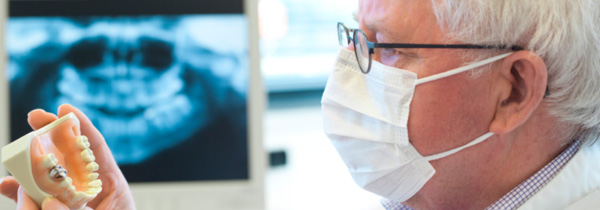Periodontitis: Moving Beyond Antibiotics for Dental Disease
Periodontal disease, also known as periodontitis, is an extremely common dental disease. Last year, the U.S. Centers for Disease Control and Prevention reported that roughly half of all American adults aged 30 or older have some form of periodontitis. Prevalence rates are thought to be fairly similar in Denmark, the United Kingdom, and other members of the EU. The key risk factors for severe periodontal diseases relate to malnutrition, tobacco use, excessive alcohol consumption, stress, diabetes mellitus, and certain other chronic diseases. About 10 to 15% of adults worldwide are thought to have severe periodontitis, with older adults being more prone to develop the disease.
Periodontitis is an inflammation of the tissues that support the teeth, notably the gum tissue. There is a progressive loss of the bone around the teeth, and this eventually results in a loosening and subsequent loss of teeth if left untreated. The underlying cause is thought to be bacteria that adhere to and grow on the tooth’s surfaces, along with an overly aggressive immune response against these microbes.
Photodynamic therapy, or PDT, can be a very effective way to kill the bacteria that cause periodontitis. A randomized clinical trial at the International Medical University in Kuala Lumpur (Malaysia) focused on 136 sites within the mouths of 16 patients with chronic periodontitis, all previously untreated. This study compared the conventional approach, known as scaling and root planing (SRP), to a combined approach that included both SRP and antimicrobial PDT (abbreviated as aPDT). The researchers carefully evaluated several aspects of periodontal status at baseline, and then again at 3, 6, and 12 months.
At all three time points in time, there were significantly greater improvements for these outcomes for the combined SRP-aPDT approach when compared to SRP alone, as reported in the 15 September 2013 issue of Lasers in Medical Science. The researchers concluded that “aPDT as an adjunctive therapy to SRP represents a promising therapeutic concept for persistent periodontitis.”
A second randomized clinical trial was conducted at the Center for Dentistry and Oral Medicine, which is located at Philipps University in Marburg, Germany. A total of 36 patients with aggressive periodontitis were randomly divided into two groups, with half receiving antibiotics (amoxicillin and metronidazole) three times a day for 7 days, and the other half receiving two PDT treatments on the day of SRP as well as one week later.
Both groups showed significant therapeutic benefits, though the antibiotic group had an even greater reduction in periodontitis and a lower number of deep pockets when compared to PDT. These findings were published in a 2013 issue of the German medical journal, Schweizer Monatsschrift für Zahnmedizin. For those cases that persist or that seem resistant to antibiotic treatment, PDT would of course be the optimal choice.
Another way by which the PDT approach could further improve the treatment of periodontitis is by boosting the natural process of tissue repair, as reported in the 30 October 2013 issue of Photodiagnosis and Photodynamic Therapy. Studies out of the Catholic University of Brasília (Brazil) suggest that PDT acts in part by reducing bone breakdown and increasing the expression of genes that are critically important for tissue repair.
Finally, the PDT approach may work best with the light-sensitizing substance known as porphyrins, as demonstrated in a recent laboratory study at the Biophotonics Laboratory of the Centre for Earth Science Studies in Akkulam, India. Porphyrins showed a very strong ability to accumulate into bacterial cells linked with aggressive periodontal disease, as reported in the 27 October 2013 issue of Photochemistry and Photobiology.
Notably, these porphyrins were able to penetrate the early-stage biofilms that tend to shield these bacteria from conventional antibiotics. Removal of the biofilm-dental plaque from tooth surfaces is considered to be one of the keys to successful treatment of periodontal diseases. The ultimate success of PDT will depend on the photosensitizer used as well as on the judgment and skill set of the physician using this technology.
Support us by buying our book, The Medicine of Light, and ebooks from our Photoimmune Discoveries eBook Series.
Sources
Alwaeli HA, Al-Khateeb SN, Al-Sadi A. Long-term clinical effect of adjunctive antimicrobial photodynamic therapy in periodontal treatment: a randomized clinical trial. Lasers Med Sci. 2013 Sep 15. [Epub ahead of print]
Arweiler NB, Pietruska M, Skurska A, Dolińska E, Pietruski JK, Bläs M, Auschill TM, Sculean A. Nonsurgical treatment of aggressive periodontitis with photodynamic therapy or systemic antibiotics. Three-month results of a randomized, prospective, controlled clinical study. Schweiz Monatsschr Zahnmed. 2013;123(6):532-44
Franco EJ, Pogue RE, Sakamoto LH, Cavalcante LL, Carvalho DR, Andrade RV. Increased expression of genes after periodontal treatment with photodynamic therapy. Photodiagnosis Photodyn Ther. 2013 Oct 30. [Epub ahead of print]
Prasanth CS, Karunakaran SC, Paul AK, Kussovski V, Mantareva V, Ramaiah D, Selvaraj L, Angelov I, Avramov L, Nandakumar K, Subhash N. Antimicrobial Photodynamic Efficiency of Novel Cationic Porphyrins towards Periodontal Gram-positive and Gram-negative Pathogenic Bacteria. Photochem Photobiol. 2013 Oct 27. [Epub ahead of print]
© Copyright 2013, Photoimmune Discoveries, BV





 English
English Français
Français Deutsch
Deutsch Nederlands
Nederlands